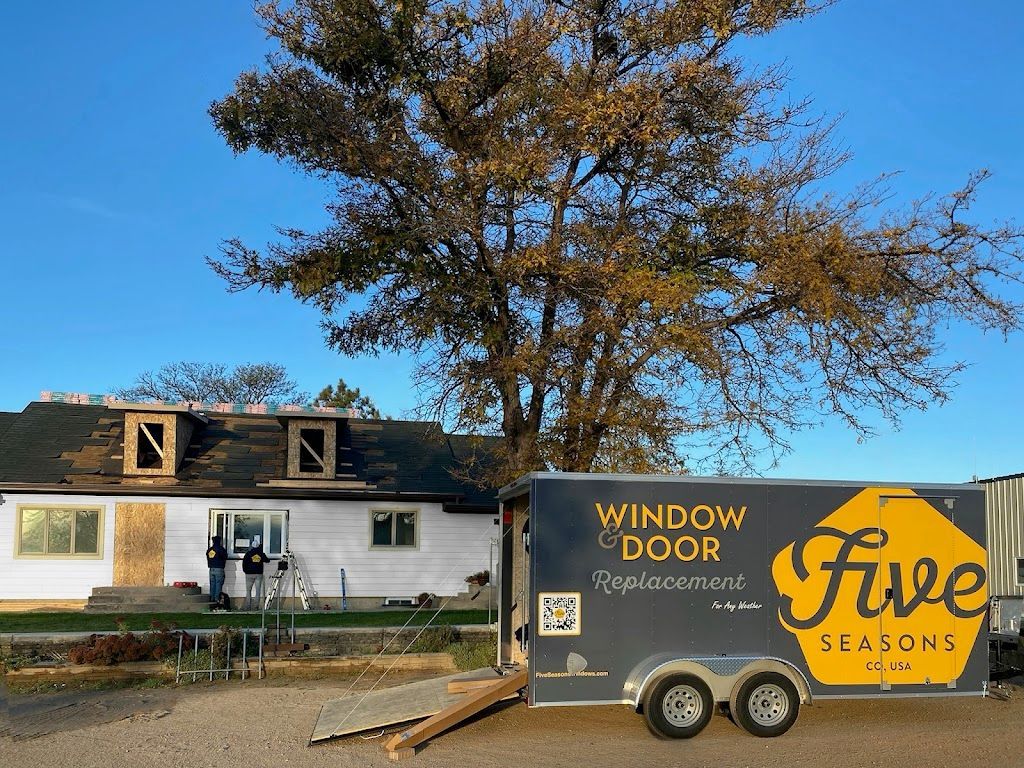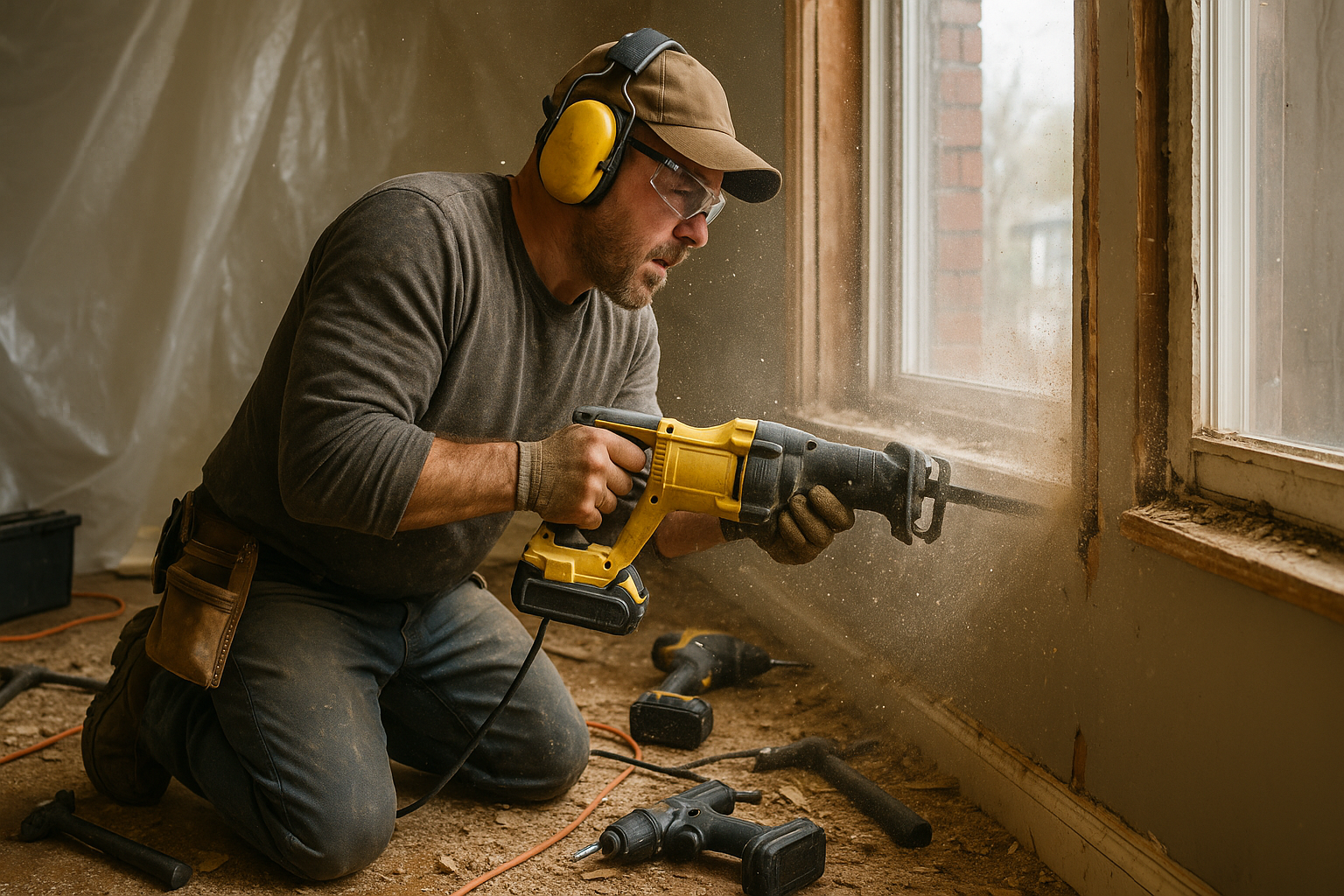Yes, new window installation generates moderate to loud noise levels (70-85 decibels) from power tools, removal of old windows, and construction activities. Most noise occurs during the first 2-4 hours of each installation day, with intermittent loud sounds throughout the project duration.
According to the Occupational Safety and Health Administration (OSHA), typical construction noise levels during window installation range from 80-90 decibels, comparable to city traffic or a garbage disposal, making advance preparation and neighbor notification important considerations for residential projects.
Window installation noise is temporary but can be disruptive to daily routines, work-from-home schedules, and neighborhood tranquility. Understanding what sounds to expect, when they occur, and how to minimize disruption helps homeowners and neighbors prepare for installation projects while maintaining positive relationships and managing expectations throughout the process.
Types of Installation Noise
Power Tool and Equipment Sounds
Window installation requires various power tools that generate significant noise levels throughout the project. Reciprocating saws for cutting old window frames produce sharp, intermittent sounds reaching 85-90 decibels, while drills and impact drivers create consistent moderate noise during hardware installation.
Hammer use for removing trim and adjusting frames creates sudden loud impacts that can startle occupants and neighbors. Air compressors for pneumatic tools produce steady background noise, while generators used when electrical power is unavailable add continuous engine noise to the work environment.
Structural Removal and Demolition
Removing old windows often requires breaking sealants, prying frames, and occasionally modifying openings, creating various loud sounds. Glass removal can produce sudden sharp noises, particularly when older sealed units are separated from frames.
Trim removal involves prying, hammering, and occasional sawing that generates irregular noise patterns throughout the removal process. Debris disposal into dumpsters or trucks creates intermittent loud impacts that punctuate the overall installation noise environment.
Typical Noise Timeline
Peak Noise Periods
The loudest installation phases typically occur during the first 2-4 hours of each workday when old windows are removed and new openings are prepared. This initial phase involves the most disruptive activities including cutting, demolition, and heavy material handling.
Installation of new windows produces moderate noise levels as frames are positioned, adjusted, and secured. The final installation phases involving trim work and cleanup generate lower noise levels but may extend throughout the day depending on project complexity.
Daily Schedule Considerations
Most professional contractors begin work between 7:00-8:00 AM and conclude by 5:00-6:00 PM, following local noise ordinances and neighborhood considerations. The most disruptive activities are typically scheduled during mid-morning hours to minimize impact on early morning and evening quiet periods.
Multi-day projects may have varying noise patterns as different installation phases require different tools and techniques. Contractors often coordinate the noisiest activities to occur on consecutive days, minimizing the overall disruption period for homeowners and neighbors.
Noise Impact on Daily Life
Work-from-Home and Remote Activities
Window installation noise can significantly disrupt video conferences, phone calls, and concentration-dependent work activities. Planning work schedules around installation timelines helps minimize professional disruption during noisy installation phases.
Consider relocating home office activities to the quietest areas of the home or scheduling important calls and meetings for times when installation noise is minimal. Some homeowners choose to work from alternative locations during the noisiest installation days.
Family and Pet Considerations
Installation noise can cause anxiety in pets, particularly dogs and cats sensitive to sudden loud sounds. Preparing safe, quiet spaces away from installation areas helps minimize pet stress during construction activities.
Young children and noise-sensitive family members may benefit from temporary relocation during peak installation hours. Planning activities outside the home during the noisiest phases can turn installation disruption into opportunities for family outings or errands.
Preparation Strategies
Advance Planning and Scheduling
Coordinate installation timing with family schedules, work commitments, and important events to minimize disruption impact. Most contractors can provide estimated timelines for different installation phases, helping homeowners plan accordingly.
Consider seasonal factors when scheduling installation projects. Summer installations may allow for open windows in unaffected areas for natural ventilation, while winter projects require careful climate control planning during installation periods.
Communication and Expectations
Discuss noise expectations and daily schedules with contractors before work begins to establish clear communication about disruptive activities. Professional contractors appreciate homeowners who understand installation requirements and plan accordingly.
Establish signals or communication methods for times when noise temporarily needs to be reduced for important calls or activities. Most contractors can accommodate brief quiet periods when given advance notice and reasonable timing requests.
Neighbor Relations and Community Considerations
Advance Notification Practices
Informing neighbors about upcoming window installation projects demonstrates consideration and helps maintain positive community relationships. Provide estimated timelines, daily schedules, and contact information for addressing any concerns during the installation period.
Written notices or personal conversations about installation plans show respect for neighbors and allow them to plan for temporary noise disruption. Many neighbors appreciate advance warning and are accommodating when they understand the temporary nature of construction activities.
Noise Ordinance Compliance
Understanding local noise ordinances ensures installation projects comply with community regulations regarding construction hours and acceptable noise levels. Most municipalities restrict construction activities to specific hours and days of the week.
Professional contractors understand local noise regulations and schedule activities accordingly, but homeowners should verify compliance and address any neighbor concerns promptly. Maintaining good community relations often depends on respecting established quiet hours and weekend restrictions.
Minimizing Disruption
Professional Contractor Selection
Experienced contractors work efficiently to minimize installation time and associated noise disruption. Quality contractors use appropriate tools, work systematically, and complete projects as quickly as safety and quality standards allow.
Contractors with neighborhood experience understand community expectations and work practices that minimize disruption while maintaining installation quality. References from recent neighborhood projects provide insights into contractors' consideration for noise management and community relations.
Once your new windows are installed, proper care and maintenance will help you get the most from your investment for decades to come. For comprehensive guidance on protecting your window investment through proven maintenance practices, explore our detailed guide: 🔗Extending the Life of Replacement Windows: Proven Tips for Maximum Longevity
Noise Reduction Techniques
Some noise reduction strategies can minimize installation impact without compromising work quality. Contractors may use sound-dampening materials around work areas or schedule the noisiest activities during periods when disruption is least problematic.
Coordinating installation activities with neighbors' schedules when possible demonstrates consideration and may prevent conflicts. Simple measures like closing windows in adjacent rooms and using temporary sound barriers can reduce noise transmission to other areas.

People Also Ask About Window Installation Noise
1. How long does the noisy part of window installation last?
The noisiest phase of window installation typically lasts 2-4 hours per window, concentrated during the removal of old windows and preparation of openings. For whole-house projects, expect peak noise levels during the first half of each installation day.
Single window replacements usually complete the noisy phases within half a day, while multi-window projects may have intermittent loud periods over 2-5 days depending on project size. The actual installation of new windows produces moderate noise levels that are less disruptive than removal activities.
Professional contractors work efficiently to minimize noise duration while maintaining quality standards. Planning installation schedules around your daily activities helps reduce the impact of temporary noise disruption on work, family, and community relationships.
2. What are the loudest tools used during window installation?
Reciprocating saws for cutting old window frames produce the loudest sustained noise at 85-90 decibels, followed by circular saws for trim work and opening modifications. Hammer impacts during frame removal create sudden loud sounds that can be startling even at moderate decibel levels.
Air compressors and generators add continuous background noise throughout the installation process, while impact drivers and heavy-duty drills create consistent moderate noise during hardware installation. Debris disposal into dumpsters produces intermittent loud impacts throughout the project.
Understanding which tools create the most noise helps plan daily activities and prepare family members and neighbors for disruptive sounds. Most contractors can provide approximate timing for when the loudest tools will be used.
3. Can window installation noise damage hearing or disturb neighbors significantly?
Window installation noise levels of 80-90 decibels are comparable to city traffic and can be uncomfortable during extended exposure, but typical installation durations rarely pose hearing damage risks to occupants. However, workers use hearing protection during extended tool use.
Neighbor impact depends on proximity, home construction, and time of day. Sound travels further in quiet neighborhoods, and installation noise can be clearly audible 100-200 feet away. Most neighbors find temporary construction noise acceptable when properly notified in advance.
Consider providing neighbors with earplugs or small courtesy gifts when projects involve extended loud activities. This gesture demonstrates consideration and often prevents complaints while maintaining positive community relationships.
4. Should I leave the house during window installation?
Leaving during the noisiest installation phases can reduce stress and disruption, but it's not necessary unless you're particularly noise-sensitive or have important work requiring concentration. Many homeowners remain home to monitor progress and address contractor questions.
Consider temporary relocation if you have young children, noise-sensitive pets, or critical work activities that cannot be interrupted. The first 2-4 hours of each installation day typically involve the most disruptive noise levels.
If staying home, prepare quiet spaces away from installation areas and have backup plans for important calls or activities. Most homeowners find that with proper preparation, remaining home during installation is manageable and allows for better project oversight.
5. Do different types of windows create different noise levels during installation?
Standard replacement windows generally produce similar noise levels during installation, as the primary noise sources are removal activities and power tool use rather than window type. However, custom or oversized windows may require additional cutting or modification work that increases noise.
Bay windows, bow windows, and architectural specialty windows often require more complex installation procedures that can extend noisy periods. These installations may involve structural modifications that increase both noise levels and duration of disruptive activities.
Emergency window replacements or installations requiring opening modifications typically produce higher noise levels and longer disruption periods. Discuss specific installation requirements with contractors to understand noise expectations for your particular project type.
Our Take
At Five Seasons Windows & Doors, we understand that installation noise is one of homeowners' primary concerns when planning window replacement projects. Our experience has taught us that clear communication about noise expectations and proactive preparation significantly improve the installation experience for everyone involved.
We make it standard practice to discuss noise timelines during pre-installation consultations, helping homeowners plan their schedules and prepare their families and neighbors appropriately. Our crews work efficiently to minimize disruption duration while maintaining the quality standards that ensure long-term window performance.
We've found that homeowners who understand what to expect and prepare accordingly report much higher satisfaction with their installation experience. By setting realistic expectations and providing practical preparation advice, we help ensure that temporary installation noise doesn't overshadow the excitement of beautiful new windows.
Final Takeaway
Window installation does generate significant noise levels, but understanding what to expect and preparing appropriately makes the temporary disruption manageable for most homeowners. The noisiest phases typically last only a few hours per day and represent a small portion of the overall project timeline.
Successful noise management involves advance planning, clear communication with contractors and neighbors, and realistic expectations about installation requirements. Most installation noise is concentrated during removal and preparation phases, with actual window installation producing more moderate sound levels.
Professional contractors work efficiently to minimize disruption while maintaining quality standards, and most neighbors are understanding when properly notified about temporary construction activities. With proper preparation and consideration, installation noise becomes a minor, temporary inconvenience on the path to enjoying beautiful, efficient new windows for decades to come.
Get Started Today
Five Seasons Windows & Doors is Colorado’s top-rated local window company with 230+ 5-star reviews. We offer expert advice, no-pressure quotes, and flexible project options — including phased installs. Schedule your consult today.




